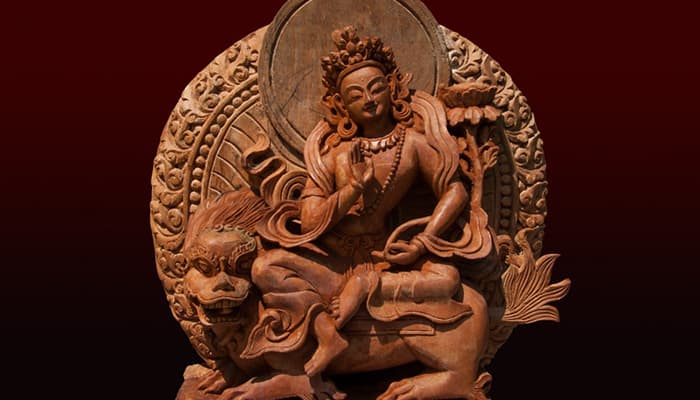Article: Who is Tara?
By Isa Gucciardi, Ph.D.
One of the oldest Stone Age artifacts that has been recovered is a small statue of a full-bodied woman carved from limestone. The statue was named the Woman of Willendorf, after the small village where it was found in southern Austria, and is estimated to be around thirty thousand years old. Many similar statues dating to the early Stone Age have been discovered throughout Europe and beyond. Expressions of the feminine have been found in the art, mythologies and spiritual practices of many ancient cultures, often represented in the form of female deities and goddesses.
Ancient images of Quan Yin, the goddess of mercy, have been found in China, Korea, Thailand and throughout southern Asia. Pachamama, the goddess of the Earth and time, has long been depicted in the traditions of the Andes Mountains of South America in stories and art. Long before Mary, the embodiment of the great feminine in Christianity, Middle Eastern and African cultures revered Isis, who presided over the other gods, life, and death. Images of Kunapipi and Eingana, the mother goddesses of the Australian aboriginal cultures, have been found in rock art dating back at least ten thousand years.
In Buddhist cultures, there are many forms of the feminine, but the most well-known is Tara, the mother of all Buddhas. Tara is a deity of love, compassion, and longevity. In the Buddhist tradition, it is understood that the awakened state emerges from the generative power of the feminine.
Like the goddesses of other cultures, Tara represents the feminine aspect of spirituality, or the “sacred feminine.” There are twenty-one different Taras, and each form reveals a unique aspect of feminine power. Tara’s many colors and forms represent her characteristics, and articulate the multi-faceted nature of the sacred feminine.
In ancient cultures, there was a deep reverence for the sacred feminine. Many societal structures centered on the respect and cultivation of her qualities. In the modern time, these essential feminine qualities have been largely forgotten, and as a consequence, our world is out of balance. By reclaiming and advocating for these qualities, we can regain balance in our current world, both individually and collectively.
Both women and men can reclaim the power of the sacred feminine by understanding what Tara symbolizes in her different forms. As we perceive these qualities and understand their application and purpose, we can measure where we are in relationship to them, comparing the way Tara embodies these values to the way we emulate them in our everyday lives. When we engage in this examination and see how well we embody the aspects of the sacred feminine, we begin a journey of self-transformation, where the depictions of Tara become the guideposts illuminating our path.
There are white Taras, blue Taras, red Taras, a black Tara, and the green Tara. One of the White Taras represents longevity and nurturing, while another is known for confronting forces that might interfere with those nurturing feminine qualities. They are often depicted sitting on a white lotus, a representation of the purity possible on each level of being– purity of mind, purity of body, and purity of speech. The lotus grows out of the mud, showing us that no matter the state of suffering or hardship we might find ourselves in, we always have access to the qualities Tara offers us.
By aligning ourselves with the power of the White Tara, we can purify our thoughts, emotions, bodies, our communications with others, and even the way we communicate with ourselves. The color white is a representation of purity, and it is believed that if we purify the aspects of our lives that prevent us from embodying the qualities of the sacred feminine, we might actually live longer.
For example, if you are angry with someone for betraying you, that anger will exhaust you over time, sapping you of your energy and power. Holding onto anger, or any strong negative emotion, distracts and limits your ability to maintain your energy and health, and your longevity can be impacted by this depletion. However, if you bring your awareness and curiosity to the anger, noticing both its origins and its triggers, you can begin to understand your relationship to it. By doing this, you can shift your relationship to the anger, allowing it to move through you and out of you in a healthy way.
When you become aware of your thoughts, you can see where the anger is before you express it. If you watch the way you express yourself, you can see how the anger moves from your thoughts to the words you choose. Bringing your attention to the way anger moves through you gives you the opportunity to pause and make different choices, and to express your anger in ways that do not harm yourself or others.
Cultivating this awareness is the first step toward transforming anger. The awareness is one antidote to the deleterious effects of strong negative emotions. As you continue to understand your anger and its consequences, you have an opportunity to move towards inner peace and replenish any energy you might have lost.
In the text, White Tara: An Offering, we gain insight into how Tara can help us confront emotions like anger:
O venerable Tara, inspire the forces that enrich life and cause spiritual energy to increase. Inspire the forces that sustain life. Inspire the forces that pacify diseases and evil. Inspire the forces that can counteract negative instincts and spiritual obscurations within the mindstream. Inspire us quickly to attain the ordinary and supreme siddhis.
“Siddhi” is a Sanskrit noun that can be translated as “accomplishment.” It is certainly an accomplishment to address the ways we shorten our own lives by indulging in negativity. In later chapters, we will examine how the practices of Tara can help us address hidden negativity within ourselves and focus us toward a more positive, life-sustaining engagement with life.
There are several Red Taras, each a different shade. One is often shown sitting on a moon disc, indicating her connection with the power of the moon. The moon represents the cycles of change, and Tara’s position on this disc symbolizes her ability to engage and dominate the cycles of time. She is peaceful, resting among garlands of flowers. This Tara is considered to be the heart of Tara herself, and is known for being able to magnetize good things into any circumstance from her seat deep within time.
In the 15th Verse of The 21 Verses in Praise of Tara, this aspect of Tara is expressed:
I prostrate to the blissful virtuous, peaceful one,
She who acts from within nirvana’s serenity.
With the pure sounds ‘Svaha’ and also ‘Om’
She annihilates even the greatest evils.
When we consider what it means to “prostrate to the blissful virtuous, peaceful one,” we can look at how we can dedicate ourselves to promoting peace, both within ourselves and in our communities. Peacefulness is an essential aspect of the great feminine that invites us to participate in activities that garner mutual benefit. When we consider how we can center our lives on peace-generating activities, we have an antidote to the despair and hopelessness we can feel when confronted by “the greatest evils” many of us experience as a result of the focus on war and harm that is so prevalent in the current time.
Another Red Tara demonstrates a fierce approach to the cultivation of peace in our lives. This Tara has four arms and holds various symbols in her hands. She is often shown with a ring of flames around her, symbolizing her ability to burn away misunderstandings and delusions— particularly misconceptions surrounding our relationship to the power of the sacred feminine.
Verse 13 of The 21 Verses in Praise of Tara vividly captures this quality:
I prostrate to she who dwells within a garland
Of flames like the aeon ending in fire.
Her right leg stretched and left withdrawn,
Joy of her followers and scourge of their foes.
With two of her main arms, she holds an arrow stretched on a flower bow. The shaft of this arrow is made of flowers, and the flight is made of leaves. The symbol of the bow and arrow indicates her ability to attain what her heart desires. Aligning ourselves with this expression of Tara can help us clarify our goals and purpose by revealing the misconceptions that may be clouding our ability to truly know ourselves.
In depictions of this aspect of Red Tara, her upper right hand holds a hook of flowers and her left hand holds a noose. Both these implements symbolize her ability to guide those who are out of alignment. In the verse, the line, “Her right leg stretched and left withdrawn,” refers to an aspect shared by many of the Taras. Her leg is outstretched as she steps forward to do what is asked of her. We too can foster this willingness to follow our path with all the guidance available to us.
Tara’s many forms reveal the complex nature of her power. One moment she is loving, extending herself to help those who are suffering. In the next moment, she is ferocious, defending against powerful negative forces.
Verse 15 is a portrait of her loving side, while Verse 8 of The 21 Verses in Praise of Tara gives us a glimpse of her ferocious side:
I prostrate to Ture, who vanquishes
The great fears, the mightiest devils.
With a wrathful twist of her lotus face,
She slays all foes without exception.
The Black Taras are perhaps the best example of this ferocity. They often wear a tiger’s skin and teeth. In this form, Tara is referred to as “the Divine Mother of compassion and a firm Goddess to ward off any form of evil.” This ability to meet fear and other obstacles with power is a valuable quality we must all cultivate. We are taught it is unseemly to express power in a direct and confrontational way, but there are situations where this stance is required. Without it, how can we face down a bully who is harming our child? Or, how can we set a proper boundary to negative intention? One of the lessons we learn from observing this fierce aspect of Tara is that by embodying fierceness, we can protect ourselves even in the most threatening situation.
Though there are many aspects of Tara, she has one characteristic that is unchanging: compassion. Even in her fiercest aspects where she is facing down forces of negativity, she approaches confrontation with compassion in her heart.
This is true of the Blue Taras, who are known for their capacity to meet negativity with great intensity while holding steady in a field of compassion. Through this catalytic activity, anger can be transmuted into wisdom. They show us how to see our problems as opportunities. As we begin to realize the obstacles we have to standing in our potential, it can be daunting. Blue Tara reminds us that by marshaling our inner strength, we can transform any obstacle into a path of insight and good fortune.
The Yellow or Gold Taras are associated with generosity and prosperity. Abundance is a key characteristic of the sacred feminine. Verse 11 of The 21 Verses in Praise of Tara captures Tara’s dedication to preserving this abundance.
I prostrate to she with power to invoke
All the armies of local protectors.
With face fiercely wrinkled and a vibrant Hum
She brings freedom from every poverty.
When we think of abundance, we often think of money and material possessions. While it is important to have enough money to be able to live as fully as we can, Tara shows us how we must free ourselves from “every poverty” before we can enjoy abundance on a material level.
The Golden and Yellow Taras teach us that this kind of abundance is possible, and it is within our reach when we focus our attention properly to attain it. We must be willing to change our self-limiting ideas about what we are allowed to have, giving ourselves permission to accept the abundance available to us.
In later chapters, we will be looking at the ways we deprive ourselves and limit the fulfillment of our needs, exploring how this self-limiting behavior affects our ability to embody the abundance of the great feminine and prevents us from making it available to those around us as well.
The Green Tara is perhaps the best known of all the Taras. She embodies compassion, protection, engagement and courage. Like many of the other Taras, she is often depicted with one leg stepping forth from a seated position, indicating her willingness to offer assistance and service to the world. Green Tara is often referred to as a savioress.
The Tibetan Buddhist monk, Bokar Rinpoche, was only eighteen when he and a group of Tibetans fled the Chinese occupation of Tibet by making a dangerous crossing of the Himalayas in 1959. Of all the deities in the Tibetan pantheon, it was Tara he and his fellow travelers called upon to assist them in finding safe passage. Here is his account of a particularly difficult moment during their journey:
The wind was driving the falling snow into high drifts all around us. The animals were struggling to find their footing. As they slipped, the bags they were carrying fell off and disappeared down the mountainside. There were sixty of us who were trying to get through the high, dangerous mountain pass before the Chinese troops who were pursuing us caught up with us.
Earlier in the journey, we had asked for guidance from Tara through divination to plan our safe escape from the Chinese troops who were overtaking our homeland. We were concerned with the results of the divination, because it indicated that the best course of action was to take the route that led over the steep mountain pass. Winter was upon us and we knew at the outset that if snow were to fall while we were traveling this route we would have great difficulty. But Tara’s direction was clear— we were not to take the easier route.
Just before the snow started falling, we had met a group of nomads coming up the mountain. They told us that they had seen Chinese troops on both sides of the pass. We could not turn back. Our only choice was to continue. The snow blinded us as we struggled on, but we maintained our determined pace until we finally made it safely to the Tibetan settlement in Nepal.
As we were warming ourselves by the fire the next morning, we learned that the Chinese troops had come very close to discovering us. While the blizzard had made it impossible for us to see even a foot in front of us, the Chinese troops had similar difficulties, and this proved beneficial since the conditions brought on by the storm hid us from their sight. By the time they reached the pass, it was no longer traversable, and they had to hunker down in the blackout conditions of the blizzard as we pushed on through the storm. If the snow had not fallen, or had fallen slightly earlier, or slightly later, we might have been caught. We could not help thinking that this timely snowstorm had been Tara’s blessing.
These monks were evoking the power of the great feminine in the form of Tara to deliver them from their difficulties. We too can invoke this power, becoming its agents as we meet the difficulties we are faced with as our own world changes in ways we could never have imagined. Tara teaches us how to develop courage, and to trust in our ability to receive guidance as we navigate the challenges of our lives.
LIKE THIS ARTICLE? SIGN UP FOR FREE UPDATES!



